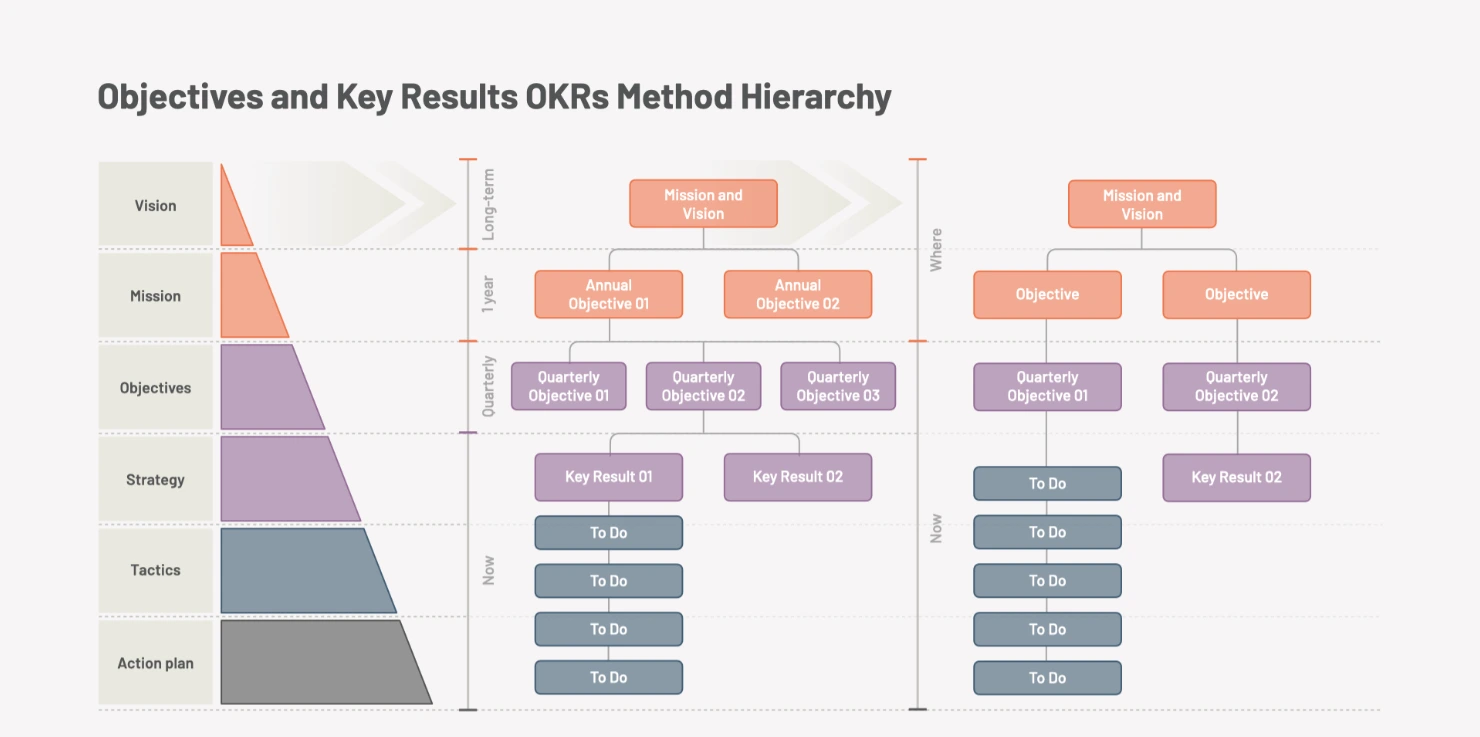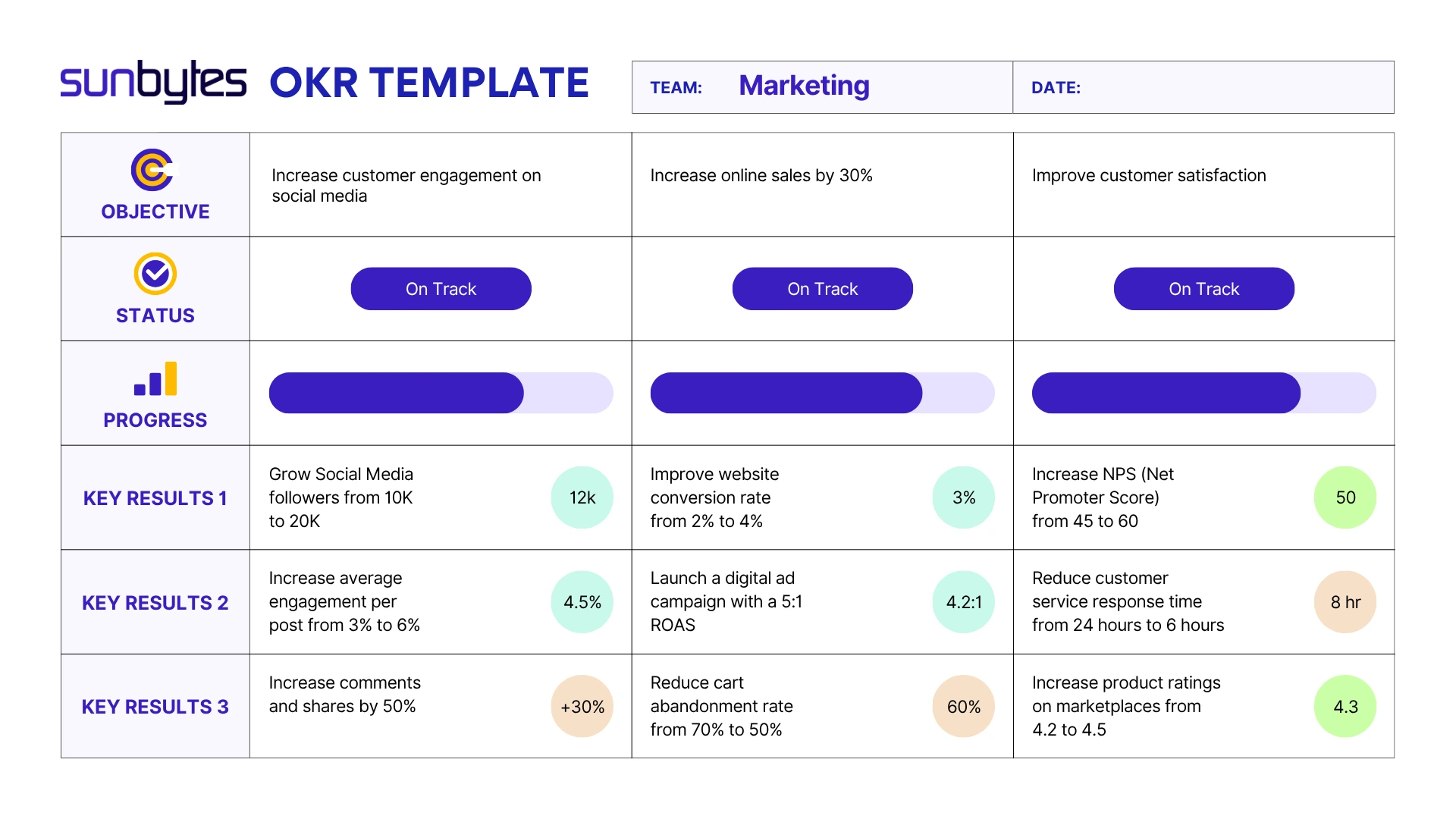Are you struggling to align your team’s efforts with your company’s most important goals? You’re not alone. 87% of organizations fail to execute their strategy effectively, often because they lack a clear framework for measuring what truly matters. Enter OKR planning (Objectives and Key Results) – the goal-setting methodology that helped Google grow from 40 employees to over 100,000, and powered companies like Intel, LinkedIn, and Spotify to unprecedented success.
In this comprehensive guide, we’ll walk you through everything you need to know about OKR planning, based on insights from John Doerr’s groundbreaking book “Measure What Matters.” By the end, you’ll have a clear roadmap to transform your organization’s goal-setting and execution.
What Are OKRs? Understanding the Basics
OKRs (Objectives and Key Results) are a powerful goal-setting framework that transforms how organizations focus their efforts and measure success. Originally developed by Intel’s Andy Grove and later popularized by venture capitalist John Doerr, this methodology has become the secret weapon behind some of the world’s most successful companies, including Google, LinkedIn, and Spotify.

For a more in-depth understanding of measuring what matters, consider “Measure What Matters” by John Doerr.
The Two-Part OKR Planning Structure
Objectives: The “What” You Want to Achieve
Objectives are qualitative, inspirational statements that define what you want to accomplish. Think of them as your north star. They should be:
- Memorable and motivational: Easy to recall and inspiring to pursue
- Qualitative: Descriptive rather than numerical
- Time-bound: Typically set for quarterly periods
- Limited in number: 3-5 objectives maximum to maintain focus
- Aspirational: Challenging enough to drive breakthrough performance
Example Objectives:
- “Become the most trusted brand in our industry.”
- “Deliver an exceptional customer experience that sets new standards.”
- “Build a world-class engineering team.”
Key Results: The “How” You’ll Measure Success
Key Results are quantitative measures that track your progress toward each objective. They serve as the measurable evidence that you’re achieving your aspirational goals. Effective Key Results are:
- Specific and measurable: Clear metrics with defined targets
- Aggressive yet achievable: Stretch goals that push boundaries
- Time-bound: Deadline-driven for accountability
- Limited per objective: 2-5 key results per objective
- Outcome-focused: Measure results, not activities
Example Key Results for “Become the most trusted brand”:
- Increase Net Promoter Score from 45 to 70
- Achieve a 95% customer satisfaction rating
- Reduce customer complaints by 50%
- Earn 25 positive media mentions per month
OKRs vs. Traditional Goal Setting
| Traditional Goals | OKRs |
| Often vague and unmeasurable | Crystal clear objectives with measurable outcomes |
| Set annually and forgotten | Quarterly cycles with regular check-ins |
| Top-down directive | Collaborative bottom-up input |
| Safe, easily achievable | Ambitious stretch goals |
| Individual focus | Team and organizational alignment |
Step-by-Step Guide to Implementing an OKRs Plan
Phase 1: Foundation (Weeks 1-2)
Week 1: Get Leadership Buy-In
- Present the OKR planning framework to the executive team with success stories
- Secure an executive sponsor who will champion the initiative
- Approve the budget for training and tools
- Set expectations for time investment (2-3 hours weekly)
Week 2: Set Up for Success
- Choose an OKR champion: Choose someone influential, organized, and persistent
- Select a pilot team (10-30 people from different departments)
- Plan pilot duration – one full quarter (12 weeks)
- Allocate resources – time, budget, and support
Phase 2: Design (Weeks 3-4)
Week 3: Create Company OKR Planning
- Executive workshop (2-3 hours) to set 3-5 company objectives
- Focus on breakthrough results that require stretch thinking
- Ensure strategic alignment with business priorities
- Make objectives inspirational and memorable
Week 4: Train and Prepare
- Develop training materials (presentations, templates, examples)
- Create a communication plan for a company-wide announcement
- Set up a tracking system (start simple with spreadsheets)
- Schedule team workshops for OKR creation
Phase 3: Launch (Weeks 5-6)
Week 5: Train Teams
- Conduct OKR training (2 hours per team)
- OKR fundamentals (45 minutes)
- Writing effective OKRs (60 minutes)
- Q&A session (15 minutes)
- Provide templates and examples
- Address concerns and questions
Week 6: Set Team OKR Planning
- Facilitate team workshops (2 hours each)
- Review company OKRs (15 minutes)
- Brainstorm team objectives (30 minutes)
- Create key results (45 minutes)
- Validate alignment (30 minutes)
- Ensure connection to company priorities
- Limit to 3-5 objectives per team
Phase 4: Execute (Weeks 7-16)
Weekly Check-Ins (15-20 minutes)
Simple agenda:
- Progress update – current status on each key result
- Confidence check – green/yellow/red for each OKR
- Obstacle discussion – what’s blocking progress?
- Weekly priorities – top 3 focus areas
- Support requests – help needed from others
Monthly Reviews
- Leadership review of all team progress
- Resource reallocation if needed
- Cross-team coordination for dependencies
- Celebrate wins and share learnings
Mid-Quarter Adjustments
- Modify the OKR plan only if major changes occur
- Document reasons for any changes
- Communicate broadly to maintain transparency
Phase 5: Review and Scale (Week 16+)
Quarter-End Activities
- Score OKRs using a 0.0-1.0 scale
- 0.7-1.0 = Excellent
- 0.4-0.6 = Good progress
- 0.0-0.3 = Needs improvement
- Conduct retrospective – what worked, what didn’t?
- Capture learnings for next quarter
- Plan next cycle improvements
Organization-Wide Rollout
- Month 1-2: Expand to 2-3 additional teams
- Month 3-4: Include all major departments
- Month 5-6: Full organization implementation

Recommended OKR Planning Software Tools
Enterprise Solutions:
- Weekdone: Comprehensive OKR platform with reporting
- 15Five: Performance management with OKR integration
- Lattice: People management platform including OKRs
- BetterWorks: Enterprise-grade OKR software
Small to Medium Business:
- Google Sheets/Excel: Simple templates for getting started
- Asana: Project management with goal tracking
- Monday.com: Work management platform with OKR templates
- Notion: All-in-one workspace with OKR databases
How to Write Effective Objectives in OKR Planning
Writing powerful objectives is both an art and a science. Great objectives inspire action, align teams, and create clarity around what success looks like. This section provides a comprehensive framework for crafting objectives that drive breakthrough results.
The INSPIRE Framework for Objectives
I – Inspirational and Motivating
Your objectives should energize people and make them excited to come to work. Inspirational objectives tap into intrinsic motivation and connect daily work to meaningful outcomes.
- “Revolutionize customer experience in our industry.”
- “Build the world’s most innovative product development team.”
- “Become the employer of choice for top talent.”
Questions to Test Inspiration:
- Would team members be excited to share this objective with their friends?
- Does this objective connect to a larger purpose or mission?
- Will achieving this objective make a meaningful difference?
N – Notable and Memorable
Memorable objectives stick in people’s minds and become part of daily conversations. They should be easy to recall without referring to documents.
Memorable Objective Techniques:
- Vivid imagery: “Build an unbreakable customer relationship fortress.”
- Emotional connection: “Create moments of delight that customers never forget.”
- Action-oriented language: “Dominate the competitive landscape.”
- Metaphorical framing: “Launch our rocket ship to market leadership.”
S – Specific to the Situation
Objectives must be relevant to your current business context and address real challenges or opportunities your organization faces.
Situation-Specific Examples:
- For a startup: “Achieve product-market fit that enables sustainable growth.”
- For a mature company: “Reinvent our core offering for the digital age”
- For a struggling team: “Transform our operational excellence and reliability.”
P – Purposeful and Meaningful
Every objective should have a clear “why” that connects to broader organizational goals and stakeholder value.
Purpose-Driven Objective Examples:
- “Empower small businesses to thrive in the digital economy.”
- “Democratize access to high-quality education globally.”
- “Protect customer data with unwavering security standards.”
I – Impactful on the Business
Objectives must drive measurable business impact and contribute to strategic priorities. They should move the needle on key performance indicators.
High-Impact Objective Characteristics:
- Addresses a significant business opportunity or challenge
- Influences multiple stakeholders or departments
- Creates sustainable competitive advantages
- Drives revenue, reduces costs, or improves efficiency
R – Relevant to Stakeholders
Consider all stakeholders who will be affected by or contribute to achieving the objective. Relevant objectives resonate with everyone involved.
Stakeholder Relevance Check:
- Customers: How does this improve their experience?
- Employees: What’s in it for the team?
- Investors: How does this drive business value?
- Partners: What collaborative opportunities exist?
E – Ethical and Responsible
Objectives should align with organizational values and ethical standards. They must be achievable through responsible means.
Ethical Objective Guidelines:
- Sustainable and environmentally conscious
- Inclusive and diverse
- Transparent and honest
- Socially responsible
Objective Writing Templates
Growth-Focused Objectives
Template: “Achieve [ambitious outcome] that [creates value] for [stakeholder group]”
Examples:
- “Achieve explosive user growth that establishes market leadership.”
- “Capture dominant market share that creates sustainable competitive advantage.”
- “Scale operations seamlessly to support 10x business growth.”
Innovation-Focused Objectives
Template: “Create [breakthrough innovation] that [transforms/disrupts] [market/industry]”
Examples:
- “Launch revolutionary AI features that transform user productivity.”
- “Develop groundbreaking technology that disrupts traditional workflows.”
- “Pioneer sustainable solutions that redefine industry standards.”
Excellence-Focused Objectives
Template: “Deliver [world-class standard] that [exceeds expectations] of [stakeholder group]”
Examples:
- “Deliver flawless execution that exceeds customer expectations.”
- “Achieve operational excellence that sets new industry benchmarks.”
- “Build world-class capabilities that attract top talent.”
Transformation-Focused Objectives
Template: “Transform [current state] into [desired future state] that [enables outcome]”
Examples:
- “Transform our legacy systems into a modern, scalable platform.”
- “Evolve our culture into a high-performance, innovation-driven organization.”
- “Reinvent our go-to-market strategy for digital-first customers.”
How to Craft Measurable Key Results in OKR Planning
Key Results are the quantitative backbone of your OKR Planning. They transform inspirational objectives into measurable outcomes that drive accountability and progress. Effective Key Results eliminate ambiguity and provide clear evidence of success.
The SMART-ER Framework for Key Results
S – Specific and Clear
Key Results must be clear and precise. Anyone should be able to understand exactly what needs to be achieved.
Specific Key Result Examples:
- Vague: “Improve customer satisfaction”
- Specific: “Achieve customer satisfaction score of 4.7 out of 5.0”
- Vague: “Increase sales performance”
- Specific: “Generate $2.5M in new customer revenue”
M – Measurable and Quantifiable
Every Key Result must have a clear metric with a defined target. If you can’t measure it, it’s not a proper Key Result.
Measurable Metric Types:
- Percentage increases: “Improve conversion rate from 3.2% to 4.8%”
- Absolute numbers: “Acquire 1,000 new customers”
- Ratios: “Achieve customer-to-employee ratio of 100:1”
- Scores: “Reach Net Promoter Score of 50”
- Time-based: “Reduce response time to under 2 hours”
A – Aggressive yet Achievable
Key Results should be challenging enough to drive breakthrough performance while remaining within the realm of possibility.
Stretch Goal Guidelines:
- 70% achievement = success for aspirational Key Results
- 100% achievement = success for committed Key Results
- Mix both types – some committed, some aspirational
Aggressive Key Result Examples:
- “Increase monthly recurring revenue from $100K to $200K” (100% growth)
- “Achieve 95% customer retention rate” (industry average is 85%)
- “Launch in 5 new markets” (previously launched in 1 market per year)
R – Relevant to the Objective
Each Key Result must directly contribute to achieving its objective. There should be a clear logical connection between the metric and the desired outcome.
Relevance Testing Questions:
- If we achieve this Key Result, will we be closer to our objective?
- Does this metric measure an outcome, not just an activity?
- Will stakeholders care about this result?
T – Time-bound with Clear Deadlines
Key Results need specific deadlines to create urgency and enable tracking.
Time-bound Examples:
- “By the end of Q1 2025”
- “Within 60 days of launch”
- “By March 31st”
- “Before the next board meeting”
E – Exciting and Motivational
Key Results should energize the team and create excitement about the challenge ahead.
Motivational Key Result Characteristics:
- Breakthrough numbers that push boundaries
- Competitive advantages that differentiate the organization
- Customer impact that creates real value
- Team recognition that builds pride
R – Regularly Reviewed and Updated
Key Results must be trackable every week, with progress visible to all stakeholders.
Review Requirements:
- Progress can be measured weekly
- Data is accessible and reliable
- Trending is visible (improving/declining)
- Confidence levels can be assessed
Key Result Formulation Framework
The Basic Formula
Formula: [Verb] + [Metric] + [From X] + [To Y] + [By When]
Examples:
- “Increase monthly website traffic from 50K to 100K visitors by the end of Q1.”
- “Reduce customer acquisition cost from $150 to $100 by March 31st.”
- “Grow email subscriber list from 5K to 15K by quarter end.”
Ratio-Based Key Results
Formula: “Achieve [ratio] of [numerator] to [denominator]”
Examples:
- “Achieve a 3:1 ratio of monthly recurring revenue to customer acquisition cost.”
- “Maintain a 95% ratio of on-time project deliveries.”
- “Reach 2:1 ratio of organic to paid traffic”
Milestone-Based Key Results
Formula: “Complete [milestone] by [date] with [success criteria]”
Examples:
- “Launch beta version by February 15th with 500 active users.”
- “Complete Series A funding round by Q1 end with $5M raised.”
- “Achieve SOC 2 certification by March 31st with zero compliance gaps.”
Threshold-Based Key Results
Formula: “Maintain [metric] above/below [threshold] for [duration]”
Examples:
- “Maintain system uptime above 99.9% for the entire quarter.”
- “Keep customer churn below 2% monthly for 12 consecutive months.”
- “Sustain employee Net Promoter Score above 70 throughout Q1.”

Common OKR Mistakes and How to Avoid Them
Setting Too Many OKRs
Teams often create 8-12 objectives per quarter, thinking everything is equally important. This approach destroys focus and overwhelms everyone with competing priorities. When teams can’t remember their OKRs without looking them up, you know there are too many.
Warning Signs:
- Teams struggle to recall their OKRs instantly
- Weekly check-ins take over an hour
- Progress feels slow across all objectives
- People feel pulled in multiple directions
The Solution
Practice ruthless prioritization and stick to proven limits. Focus on breakthrough impact rather than comprehensive coverage.
- Limit to 3-5 objectives maximum per quarter
- Use 2-4 key results per objective only
- Apply the “Rule of 3” – if you can’t name your top 3 OKRs instantly, cut some.
- Ask tough questions – which goals will truly move the needle?
Wrong Ambition Level
Teams set goals that are either too easy (guaranteeing success) or impossibly ambitious (guaranteeing failure). Both approaches undermine the entire OKR system and destroy team confidence.
Sandbagging Signs:
- Consistently achieving 100% of all OKRs
- Goals require minimal effort or innovation
- Targets based on “what we’re already doing”
- Risk-averse, status-quo thinking
Impossible Goals Signs:
- Teams immediately lose confidence
- Consistent 20% or lower achievement rates
- Goals requiring unavailable resources
- Objectives ignoring market realities
The Solution
Target the 70% achievement sweet spot for stretch goals. Mix committed OKRs (should achieve 100%) with aspirational ones (70% target).
Calibration Techniques:
- Review historical performance to set realistic baselines
- Assess available resources honestly
- Research industry benchmarks and competitive landscape
- Stress test assumptions – what needs to be true for success?
Poor Alignment Between Levels
Team OKRs don’t support company objectives, causing wasted resources on activities that don’t drive strategic outcomes. Success feels hollow when it doesn’t impact business results.
Misalignment Symptoms:
- Team goals disconnected from company priorities
- Competing objectives between departments
- Individual work not supporting team goals
- Achieving OKRs without business impact
The Solution
Create transparent cascading processes that ensure every goal connects to organizational success.
Alignment Framework:
- Start with company OKRs and communicate context clearly
- Enable collaborative cascading where teams propose their contributions
- Validate cross-team alignment to prevent conflicts
- Draw clear connections from individual work to company success
Linking OKRs to Performance Reviews
When OKRs directly impact compensation or job security, teams sandbag goals to protect themselves. This destroys the stretch mindset that makes OKRs powerful.
Performance Integration Problems:
- Conservative goal setting to ensure bonuses
- Blame and defensiveness when missing targets
- Focus on individual achievement over team success
- Reduced innovation and risk-taking
The Solution
Separate OKRs from performance evaluations completely. Focus on learning and improvement rather than judgment.
What to Include in Reviews:
- Quality of the goal-setting process and collaboration
- Learning and adaptation from challenges
- Effort and innovation in pursuing objectives
- Teamwork and support for others’ success
What NOT to Include:
- Percentage of OKRs achieved or specific scores
- Blame for missed stretch goals or ambitious targets
- Penalties for taking risks or pushing boundaries
Set-and-Forget Mentality
Teams create beautiful OKRs at quarter start, then ignore them until the end. This wastes opportunities for course correction and eliminates the accountability that drives results.
Neglect Warning Signs:
- Monthly or less frequent OKR discussions
- Outdated progress data sitting unchanged
- Quarter-end surprises about performance
- Decisions made without considering OKRs
The Solution
Establish rhythmic accountability through consistent check-ins and updates.
Weekly Check-in Structure (15-20 minutes):
- Progress updates with actual data and evidence
- Confidence assessment using green/yellow/red indicators
- Obstacle discussion focusing on solutions, not blame
- Priority setting for the upcoming week
- Support requests and resource needs
Monthly Activities:
- Leadership reviews across all team progress
- Resource reallocation based on performance
- Success story sharing and learning capture
Activity Focus Instead of Outcomes
Teams write Key Results measuring what they’ll do rather than what they’ll achieve. This leads to busy work instead of meaningful progress toward objectives. OKRs such as “Conduct 50 customer interviews” (activity) or “Launch 3 marketing campaigns” (activity) are not effective in measuring productivity.
The Solution
Transform activities into outcome-focused Key Results by asking what specific results these activities will produce. For example, “Conduct 50 customer interviews” => “Achieve product-market fit score of 40% based on customer validation”
Inconsistent Scoring
Without clear criteria, teams inflate or deflate scores based on emotions rather than evidence. This reduces learning value and creates confusion about what success looks like.
Inconsistent Scoring Signs:
- Dramatic score variations for similar achievements
- Disagreement about whether goals were met
- Emotional rather than data-driven assessments
- Lack of supporting evidence for scores
The Solution
Use objective, evidence-based scoring frameworks that everyone understands and applies consistently.
Scoring Framework:
- 1.0 (Excellent): All targets fully met with clear evidence
- 0.7 (Good): Significant progress with most milestones completed
- 0.4 (Fair): Meaningful advancement with some milestones reached
- 0.0-0.3 (Poor): Minimal progress with few milestones completed
You should remember that Most OKR failures stem from poor implementation rather than flawed methodology. Focus on consistently executing these fundamentals rather than perfecting OKR writing. Success comes from disciplined practice over time.
Key Takeaways: Your OKR Planning Success Roadmap
Successful OKR planning requires commitment, patience, and continuous learning. Remember these essential principles:
- Start Small: Begin with a pilot program before company-wide rollout
- Focus on Learning: Treat your first cycles as experiments
- Maintain Alignment: Ensure clear connections between all levels
- Track Progress: Regular check-ins are crucial for success
- Embrace Stretch Goals: 70% achievement of ambitious goals is success
This comprehensive guide provides everything needed to successfully implement and scale OKRs throughout your organization. Remember that OKR mastery develops over time; focus on consistent application and continuous learning rather than perfection from the start.
Start with the basics, learn from your experience, and gradually build the sophisticated OKR practice that will drive your organization to new levels of achievement and success.
Frequently Asked Questions
OKRs should be set quarterly, with weekly check-ins to track progress. The objectives typically remain stable for the quarter, while tactics and action plans may adjust based on learnings and changing circumstances.
KPIs (Key Performance Indicators) measure ongoing business health, while OKRs focus on achieving specific outcomes within a timeframe. KPIs are typically maintained at steady levels, whereas OKRs drive change and improvement.
It depends on your organization’s size and culture. Many companies start with team-level OKRs and add individual OKRs later. Personal OKRs work best when they connect to team objectives and focus on contribution rather than individual achievement.
OKRs should be stable enough to provide focus but flexible enough to adapt to significant changes. If priorities shift dramatically, it’s acceptable to modify or replace OKRs, but document the reasons and learnings from the change.
For stretch OKRs, achieving 70% is considered successful. If you’re consistently hitting 100% of your OKRs, they may not be ambitious enough. A healthy mix includes some committed OKRs (should achieve 100%) and aspirational OKRs (70% target).


